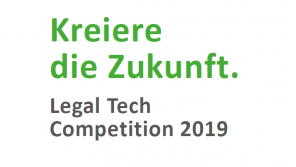Legal Tech Blog introduces a new series of posts which will discuss interesting books for those who would like to understand where the legal industry might be heading and which forces might drive changes. All books presented in this series will explain in one way or another why we will work differently as legal service providers in the future. The first book in this series is „A Whole New Mind: Why Right-Brainers Will Rule the Future“ by Daniel H. Pink. Please enjoy.
The business world, and with it the legal market, is changing rapidly, amongst others thanks to Legal Tech. Accordingly, the skills necessary for success are changing as well. The last few decades belonged to a particular kind of person with a certain kind of mind. But the keys to the kingdom are changing hands according to Daniel H. Pink. In his book “A Whole New Mind: Why Right-Brainers Will Rule the Future”, he describes how lawyers who could craft contracts and MBAs who could crunch numbers will be replaced by pattern recognizers and big picture thinkers when it comes to reaping society’s richest rewards. The book was first published in 2005 and it is a long-running New York Times and BusinessWeek bestseller. It has been translated into 20 languages.
Pink is the author of several books on business, work, and management. He received a post-graduate law degree (J.D.) from Yale Law School and served as editor-in-chief of the Yale Law & Policy Review. In addition his talk on The Puzzle of Motivation is one of the most-watched TED Talks.The Puzzle of Motivation is one of the most-watched TED Talks.
Introduction
Pink argues that we are moving away from an economy and a society built on the logical, linear, computer-like capabilities of the Information Age towards an economy and a society built on the inventive, empathic, big-picture capabilities of what is rising in its place, the Conceptual Age. He identifies six essential aptitudes, which he calls the six senses and on which professional success and personal satisfaction will depend on. These are design, story, symphony, empathy, play and meaning. For exercise purpose, the book includes several hands-on examples to help readers sharpen the necessary abilities.
Part One – The Conceptual Age
Right Brain Rising. Pink starts by describing the rising importance of the right side of the brain. The two halves look the same, but in form and function they are quite different. The left hemisphere reasons sequentially, excels at analysis, and handles words. The right hemisphere reasons holistically, recognizes patterns, and interprets emotions and nonverbal expressions. Human beings are therefore literally of two minds, but both halves play a role in nearly everything we do.
The human brain is contralateral – that is, each half of the brain controls the opposite half of the body. Since roughly 90 percent of the population is right-handed, that means that for roughly 90 percent of the population, the left hemisphere is controlling important movements such as handwriting, eating, and maneuvering a computer mouse.
The left hemisphere is particularly good at recognizing serial events – events whose elements occur one after the other – and controlling sequences of behavior. The left hemisphere is also involved in controlling serial behaviors. The serial functions performed by the left hemisphere include verbal activities, such as talking, understanding the speech of other people, reading, and writing. By contrast, the right hemisphere does not march in the single-file formation of A-B-C-D-E. Its special talent is the ability to interpret things simultaneously. This side of the brain is specialized in seeing many things at once – in seeing all the elements of a situation and understanding what they mean.
When it comes to interpreting conversations, the left hemisphere handles what is said and the right hemisphere focuses on how it is said. In general terms, the left hemisphere participates in the analysis of information. In contrast, the right hemisphere is specialized in synthesis. It is particularly good at putting isolated elements together to perceive things as a whole. The left focuses on categories, the right on relationships. The left can grasp the details, but only the right hemisphere can see the big picture. Both sides work together but have different specialties. In the end, yin always needs yang.
Abundance, Asia, and Automation. In the second chapter of the first part, Pink introduces the three forces which in his opinion will shape the future of global business.
The first force is abundance. For most of history, the life of humans was defined by scarcity. But today, Pink argues, the defining feature of social, economic, and cultural life in much of the world is abundance. Therefore for a business, it is no longer enough to create a product that is reasonably priced and adequately functional. It must, in addition, be beautiful, unique, and meaningful. In an age of abundance, appealing only to rational, logical, and functional needs is woefully insufficient. That is why more people – liberated by prosperity but not fulfilled by it – are resolving the paradox by searching for meaning.
The second defining force for the future is, in Pink’s opinion, the outsourcing of work, especially to Asia. A lot of jobs can and ultimately will be done cheaper in a foreign country. In the second half of the twentieth century routine mass production jobs moved across the ocean. And just as those factory workers had to master a new set of skills and learn how to bend pixels instead of steel, many of today’s knowledge workers will likewise have to command a new set of aptitudes. They will have to do what workers abroad cannot do equally well for much less money. In the future they have to use their right hemisphere abilities such as forging relationships rather than executing transactions, tackling novel challenges instead of solving routine problems, and synthesizing the big picture rather than analyzing a single component. Unfortunately Pink – being an US-American lawyer – only writes about English-speaking jobs. In my opinion, German lawyers have the advantage of a unique and not very widespread language as well as a different legal system. Presumably, this will slow down, but not prevent the process of outsourcing altogether.
Finally, the automation of work will shape the future of the business world. During the last century, machines proved they could replace human backs. Pink argues that in this century new technologies are proving they can replace human left brains. Just ask Garry Kasparov, the chess grand master, who lost a six-game match to an IBM computer called Deep Blue in 1997. Chess is in many ways the quintessential left-brain activity. It leaves relatively little room for emotion and depends heavily on memory, rational thinking, and brute calculation, two things at which computers excel. Yet, Kasparov believed that human beings had other advantages that would level the sixty-four-square playing field. Obviously, he was wrong.
In several endeavors that depend heavily on rule-based logic, calculation, and sequential thinking computers are simply better, faster, and stronger. In addition, they don’t get headaches, worry what the audience thinks or care what the press will say. The legal profession is seeing a similar pattern. Dozens of inexpensive information and advice services are reshaping the law practice. For example, CompleteCase.com will handle a divorce in the USA for a fraction of an attorney’s salary. At the same time, the web is cracking the information monopoly that has long been the source of many lawyers’ high incomes and professional mystique. Attorneys on average charge a three-figure sum per hour. But many websites now offer basic legal forms and other documents for much less. Therefore, the legal industry may be on the verge of fundamental changes that could reduce the demand for traditional services and force lawyers to lower their fees. The attorneys who succeed will be those who can tackle far more complex problems and those who can provide something that databases and software cannot.
High Concept, High Touch. In the third chapter of the first part Pink concludes that, as the forces of abundance, Asia, and automation deepen and intensify, a new era has begun. He calls it the Conceptual Age. In short, the world has progressed from a society of farmers to a society of factory workers to a society of knowledge workers. And now the world is progressing yet again to a society of creators and empathizers, of pattern recognizers and meaning makers. In the past, the economy was first built on peoples’ backs, which was later mainly replaced by an economy built on peoples’ left brains. Today the economy is more and more built on peoples’ right brains. To survive this age, individuals and organizations must examine what they are doing to earn a living and ask themselves three questions:
• Can someone overseas do it cheaper?
• Can a computer do it faster?
• Is what I am offering in demand in an age of abundance?
Because of these changes, Pink argues that high tech is no longer enough. He holds the notion that we will need to supplement our well-developed high-tech abilities with abilities that are high concept and high touch. High concept in his words involves the capacity to detect patterns and opportunities, to create artistic and emotional beauty, to craft a satisfying narrative, and to combine seemingly unrelated ideas into something new. High touch involves the ability to empathize with others, to understand the subtleties of human interaction, and to stretch beyond the quotidian in pursuit of purpose and meaning.
High-concept and high-touch aptitudes are moving from the periphery of our lives to the center. In the past successful business people obtained an MBA. Now, according to Pink, one of the hottest credentials is the MFA, the Master of Fine Arts. Whereas decades ago only very few universities offered creative writing MFA programs, nowadays some 240 U.S. universities have established such master programs. Today more people work in arts, entertainment, and design than as lawyers, accountants, and auditors. When routine legal research goes overseas and basic legal information is available online, Pink asks, what’s left for the litigious. High-concept work like that done by Animators at Law for example, a graphic design firm staffed by law graduates that prepares exhibits, videos, and visual aids to help top trial attorneys persuade juries.
Part Two – The Six Senses
In the Conceptual Age, Pink argues, we will need to complement our reasoning by mastering six essential aptitudes. These six senses are design, story, symphony, empathy, play, and meaning. Together these six high-concept, high-touch senses can help to develop the whole new mind this new era demands.
Design. In the opinion of Pink, utility enhanced by significance, also known as design, has become an essential aptitude for personal fulfillment and professional success for at least three reasons. First, thanks to rising prosperity and advancing technology, good design is now more accessible than ever, which allows more people to partake in its pleasure. Second, in an age of material abundance, design has become crucial for most modern business as a means of differentiation and as a way to create new markets. Third, as more people develop a design sensibility, the people will increasingly be able to deploy design for its ultimate purpose: changing the world.
Companies traditionally have competed on price or quality, or some combination of the two. But today decent quality and reasonably price have become merely table stakes in the business game. Once companies satisfy those requirements, they are left to compete less on function or financial qualities and more on ineffable qualities such as whimsy, beauty, and meaning.
In my opinion, you can recognize a similar development in law. Because of high transparency the costs of legal advice have leveled. In Germany, there is even an act in force which governs how much an attorney may and has to charge for his service. In addition, on a certain level the quality of the service is also pretty similar. The design may be more important in other industries, but if almost everything else is identical, a comprehensive design could make the difference. Big law firms now spend big bucks to transport their corporate identity on their letter heads and marketing materials. The legal press even reports on new developments in the area of typefaces.
To exercise the design sense Pink recommends buying a design notebook and taking notes on great and flawed designs and what differentiates them. In addition, he proposes to read design magazines or visit design museums.
Story. Today, facts are ubiquitous, often free, and available at the speed of light. When facts become so instantly accessible, each one becomes less valuable. What begins to matter more, Pink argues, is the ability to place these facts in context and to deliver them with emotional impact. And that is the essence of the aptitude of story: context enriched by emotion. Storytelling doesn’t replace analytical thinking, but it supplements it by enabling us to imagine new perspectives and new worlds.
Today, at Columbia University, all second-year medical students take a seminar in narrative medicine in addition to their hard-core science classes. They learn to listen more emphatically to the stories their patients tell and to understand those stories with greater acuity. Instead of asking a list of computer-like diagnostic questions, these young doctors broaden their inquiry.
In my opinion, the same approach could help lawyers to better relate to their clients and to assess the current situation in the context of that person’s full life story. Of course, narrative competence cannot replace technical and methodical expertise. Additionally, attorneys are only able to solve legal problems and not the underlying issue, which often is the real course of the trouble. But by carefully listening to the whole story, attorneys are able to adjust their actions more satisfyingly for the clients. The same sense is essential in a pitch. A lawyer doesn’t sell an isolated service, but the full story of his law firm.
To train the story sense, Pink recommends, writing a mini-saga with a length of exactly fifty words, no more and no less. Or ask someone to feed you an opening line of a story and then use it as a springboard to tell a made-up one. Or watch people in large public spaces and come up with a story of who they are and what they are doing.
Symphony. The ability to put together the pieces is called symphony by Pink. It is the capacity to synthesize rather than to analyze, to see relationships between seemingly unrelated fields, to detect broad patterns rather than to deliver specific answers, and to invent something new by combining elements nobody else thought to pair. Symphonic thinking is a signature ability of composers and conductors, whose jobs involve corralling a diverse group of notes, instruments, and performers and producing a unified and pleasing sound.
Symphony is largely about relationships. People who hope to thrive in the Conceptual Age, Pink argues, must understand the connections between diverse, and seemingly separate, disciplines. They must know how to link apparently unconnected elements to create something new. Pink identifies three types of people, who have this ability: The boundary crosser can operate in different realms. The inventor often just combines two existing ideas nobody else ever thought to unite and then there is the metaphor maker, who is able to deliver and understand one thing in terms of something else.
This is, in my opinion applicable to the legal world as well. Because of to the trend of decomposing the legal work, leaders of teams become nowadays more legal project managers than attorneys at law. Every single part of the service is done by the necessary qualified but cheapest member of the team. At the end, the team-leader, mostly the partner, has to recombine the output. Thereby an eye for symphony doesn’t hurt.
The symphony sense can be exercised by listening to symphonies, not surprisingly. In addition, Pink recommends learning how to draw because drawing is like symphony largely about relationships. At last, he highlights that the question “why?” can lead to understanding, but the question “why not?” can lead to breakthroughs. If you want a creative life, do what you can not and experience the beauty of the mistakes you make.
Empathy. The ability to imagine being in someone else’s position and to intuit what that person is feeling is called empathy. It is the ability to walk in somebody else’s shoes, to see through with their eyes, and to feel with their hearts. Empathy is the ultimate virtual reality.
But empathy like many of the other high-concept, high-touch aptitudes wasn’t always given its proper due in the Information Age. It was often considered a softhearted nicety in a world that demanded hardheaded detachment. The Conceptual Age puts a premium on this elusive channel. Endowing computers with emotional intelligence has been a dream for decades, but even the best scientists in the field of affective computing have not made much progress. The work that remains will demand a much deeper understanding of the subtleties of human interaction than ever before.
This is true for a field not typically known for emotional literacy: the practice of law. Much basic legal research can now be done by lawyers in other parts of the world. Likewise, software and websites have eliminated the monopoly lawyers once had on certain specialized information. So which lawyers will remain, Pink asks. Those who can empathize with their clients and understand their true needs. Those who can sit in a negotiation and figure out the subtext of the discussion that’s coursing beneath the explicit words. And those who can look at a judge or jury, read the expressions, and instantly know whether they are making a persuasive case. These empathic abilities have always been important to lawyers, but now they have become the key point of differentiation.
To sharpen your empathy Pink recommends volunteering somewhere in your community that serves people whose experiences are far different from your own. Or next time you are waiting somewhere, try to listen what the people around you are saying. Then imagine yourself as one of those people in that particular situation. By the way, psychologists have developed an array of tests to measure individual empathy and related qualities.
Play. Like its five sibling senses, play is emerging from the shadows of frivolousness and assuming a place in the spotlight. Homo ludens (Man the Player) is proving to be as effective as Homo sapiens (Man the Knower) in getting the job done. Play is becoming an important part of work, business, and personal well-being, its importance manifesting itself in at least two ways: games and humor.
A growing stack of research shows that playing games, especially video games, can sharpen many of the skills that are vital in the Conceptual Age. Playing video games enhanced individuals’ ability to detect changes in the environment and their capacity to process information simultaneously. There is also evidence that playing video games enhances the right-brain ability to solve problems that require pattern recognition.
Humor, used skillfully, greases the management wheels. It reduces hostility, deflects criticism, relieves tension, improves morale, and helps communicate difficult messages. And humor can be a cohesive force in organizations as anyone who’s ever traded jokes at the water cooler or laughed over lunch with colleagues understands. Pink argues that it is time to rescue humor from its status as mere entertainment and recognize it for what it is – a sophisticated and peculiarly human form of intelligence that cannot be replicated by computers and that is becoming increasingly valuable.
This approach can, in my opinion, be applied to the legal world as well. Only a few attorneys really work alone, most of them are part of a team of some variety. And people who laugh together can work together. The same is true for negotiations or meetings with clients. No one wants a buffoon as legal adviser, but the ability to deliver the service with a little humor can be the vital difference to a computer.
To exercise your play sense, Pink recommends trying to understand video games, which means playing them. Or next time you hear a joke, laugh first and then try to figure out what made it humorous by reverse-engineering the joke. You will gain a deeper understanding of which kind of humor works and, more important, which doesn’t.
Meaning. Freed from the struggle for survival, we have the luxury of devoting more to the search for meaning. Therefore, meaning has become a central aspect of our work and our lives. Pink describes two whole-minded ways to begin the search for meaning: spirituality and happiness.
In the Conceptual Age, as more companies grasp this idea, Pink argues that we are likely to see a rise in meaning in business – a growing demand from individuals for workplaces that offer meaning as well as money.
This change has, in my opinion, also arrived in the legal world. Fewer young professionals are willing to work for the big law firms despite the ridiculous six-figure starting salaries. They choose meaning over money. A few law firms try to counter with the possibility to work on Pro Bono cases from time to time. At Hogan Lovells, a leading global law firm, every employee is asked to devote at least 25 hours a year to citizenship activities. This policy is welcomed by job applicants as well as many clients.
Pink recommends exercising your sense of meaning by saying thanks – pure and simple. Feelings of gratitude enhance well-being and deepen one’s sense of meaning. Or ask yourself whether you would still do what you are doing, if you had won in the lottery. If the answer is a loud and confident no, that ought to tell you something.
Afterword
The Conceptual Age is dawning. Those who want to succeed in it have to pay more attention to the high-concept and high-touch abilities. The current changes present both promise and peril. The group of people, who develop a whole new mind, will do extremely well. The rest – those who move slowly or not at all – may miss out. The choice is yours.




